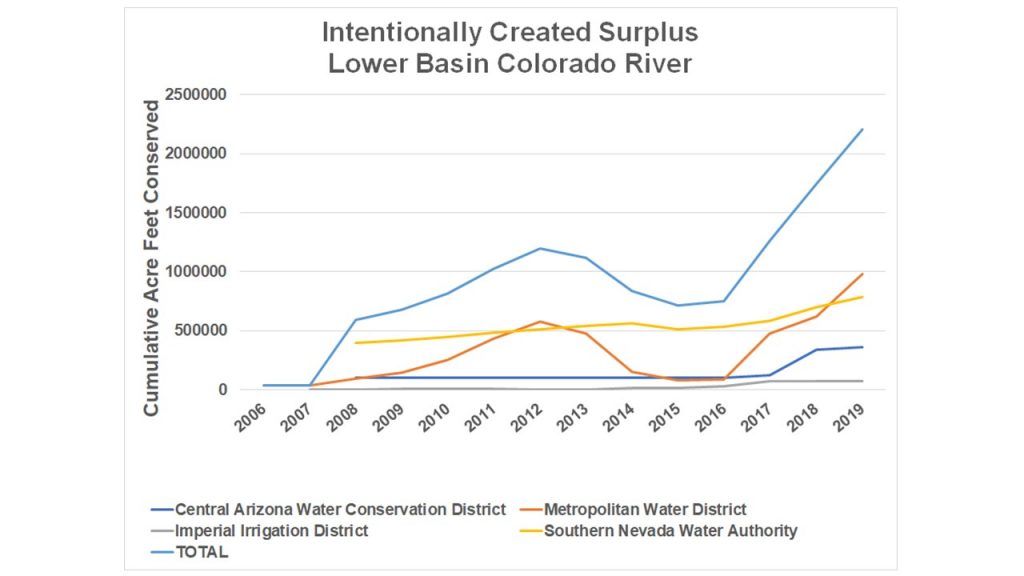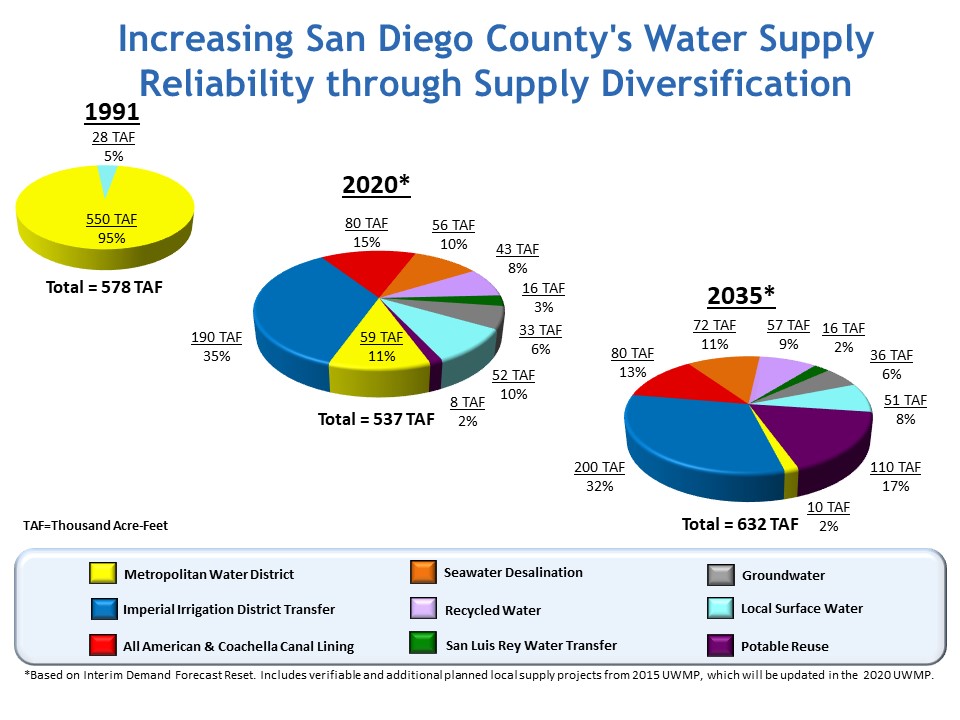Are Lake Powel and Lake Mead Filling Up Again
Bad News for Lake Powell
Equally of Monday, the National Oceanic and Atmospheric Administration's (NOAA) forecast for this year'due south expected water supplies in the Colorado River is at 59% of average. That's non good news.
If that prediction proves true, this will exist 1 of the driest h2o years since Lake Powell was constructed nearly sixty years ago. The volume of water stored in Lake Powell each year is affected past three primary factors: the amount of water flowing into the reservoir after 'Upper Basin' water users accept extracted water for their use, minus water released from the reservoir to support Lower Basin water users, and minus evaporation from the reservoir itself. Lake Powell will lose – by my estimation — about 22 feet of water this twelvemonth, or about 2.1 million acre-feet (MAF) of storage.
At that point, the reservoir will be sixty% empty.
If we run into four more years at this pace of reservoir loss — which nearly matches the charge per unit at which Lake Powell lost water during 2000-2004 when information technology went from full to half-full — the reservoir could be functionally dry past 2024 , meaning that information technology will become physically incommunicable to release enough water from Lake Powell to fulfill the Lower Basin's share of the river.
Lake Mead Volition Drop As Well
The Bureau of Reclamation plans to release 8.23 MAF of water from Lake Powell into the Lower Basin this yr. For context, releases in contempo years take averaged nearly 9 MAF, and those high releases had a large consequence on draining Lake Powell over the past xx years, but the 'extra' water flowing downstream into Lake Mead slowed its decline substantially. With a release this yr of 8.23 MAF from Lake Powell, nosotros can await Lake Mead's levels to drop again. The extent of that drop, of course, depends upon how much h2o is taken out of Lake Mead and consumed in the Lower Basin.
If the Lower Basin water users consume at the average recent charge per unit (i.e., past five years), Mead will lose near 1.2 MAF (a xv-foot drib); if they tin can manage to consume merely what they consumed last year (the everyman in 22 years), Mead would lose only well-nigh 0.seven MAF (a 9-human foot drib).
I don't await the Lower Basin's water use this twelvemonth to be as low as last year. In California, the Metropolitan H2o Commune of Southern California (MWD) is expecting to receive only 15% of their allocation in the State Water Project (i.e., water imports from Northern California) due to a very meager snowpack in the Sierra Nevada this year. Equally a upshot, MWD has signaled their intent to accept nearly twice as much water from the Colorado River this year as compared to last year's take.
By twelvemonth's cease, Lake Mead will likely be somewhere around 65% empty.
The Fragile Balancing Act between Lake Mead and Lake Powell
Under a mind-boggingly complicated set of rules chosen the "2007 Interim Guidelines," the US Bureau of Reclamation has some flexibility in deciding how much water to release from Lake Powell. For example, they could reduce the releases from 8.23 MAF (the charge per unit planned for this yr), downwards to every bit low as seven MAF in future years to keep Lake Powell from draining completely. The idea is that this flexibility in release rates enables Reclamation to "share the pain" between water users in the Upper and Lower Basins.
Nevertheless, any reduction in Powell releases below 8.23 MAF will crusade increasingly astringent pain in the Lower Basin. By next twelvemonth, the Lower Basin h2o users could realistically be facing a mandatory reduction of ~10% of their share of the river due to dropping h2o levels in Lake Mead.
A recent economical assessment estimated that a ten% reduction of water across the basin would crusade a loss of $83 billion in economic action in just one yr. If just the Lower Basin water users face h2o cutbacks, we might cut that dollar number in half. Information technology would incur a loss of 'simply' $42 billion.
I can't imagine how controversial this determination — near how much water to release each year from Lake Powell — will get if nosotros are in fact entering into a string of bad runoff years similar to 2000-2004. But……………….
We Could Instead Be Refilling the Reservoirs!
It'southward time to shift from this "lose-lose" situation to the "win-win" opportunities that will emerge if we can start implementing measures that will stabilize and and then rebuild water levels in Lake Powell and Lake Mead. In recent weblog posts, I've been pretty clear about the need to abort these reservoir declines and brainstorm to refill the reservoirs then that those dependent on Colorado River water tin can avoid severe cutbacks in their commanded water utilize in coming years and we don't push endangered species into extinction. And now we have a well-respected political leader maxim the aforementioned in this OpEd from Bruce Babbitt, a erstwhile Interior Secretarial assistant and past Governor of Arizona.
Below I'll briefly discuss two contempo developments that illustrate how water savings can exist accomplished on both farms and in cities.
Intentionally Created Surplus in the Lower Basin
The Acting Guidelines created an opportunity for farming and urban entities to leave some of their water in Lake Mead when they don't need all of their water entitlement, known equally "Intentionally Created Surplus" or ICS. This program benefits Lake Mead considering ICS stored in the lake helps to raise the water level. The graph below tracks the success of four entities that accept been participating in the program to date.

Similar to a financial banking concern account, when an entity 'banks' water in Lake Mead equally office of the ICS program, they have the opportunity to withdraw that water in the future. As y'all tin can see in the graph, the Metropolitan H2o District of Southern California (MWD) made a series of withdrawals from their account during 2013-2015 that depleted Lake Mead'south storage by 486,000 acre anxiety.
If we can find a way to incentivize some of the creators of these ICS credits for permanently depositing their surplus water in the reservoir, it would be immensely helpful in stabilizing and somewhen rebuilding reservoir levels in the futurity, a point illustrated beneath by the Mohave Valley Irrigation and Drainage Commune in Arizona.
Opportunities for Farmers to Help Conserve H2o
There are many ways that farmers tin reduce their consumptive use of water, particularly if they are financially incentivized to do so (see my blog post on Growing Water).
This year, the Mohave Valley Irrigation and Drainage Commune (MVIDD) was approved past the Agency of Reclamation to join the club of entities creating ICS credits. They plan to save water by temporarily fallowing a portion of the alfalfa grown in the District. Their plan this year is to fallow 1,200 acres, reducing their consumptive use by half-dozen,100 acre-feet.
However, their participation in the ICS program in future years will likely depend upon whether at that place is a funding source to compensate them for saving water and leaving it in Lake Mead.
Opportunities for Cities to Help Conserve Water
3 of the entities that have been participating in the ICS programme to date are urban h2o providers, and they have been able to save huge volumes in recent years. In 2019, the Metropolitan Water Commune of Southern California (MWD) banked more than than 400,000 acre-feet (note: it takes ~80,000 acre-feet of water savings to raise Lake Mead by one foot from its electric current level, so MWD raised the lake by about v feet this by year).
Potential exists for even greater savings from urban water utilities in the time to come. However, this potential is at present constrained in two ways. Offset, at that place is a cap on how much the Agency of Reclamation will allow to be stored as ICS in each year (625,000 AF/year max), every bit well as a cap on the cumulative book of ICS that tin can be stored (two.7 MAF max). This doesn't make sense given that electric current over-employ of the lower river is around 1.ii MAF/year, and there is 17 MAF to be refilled!
A second constraint is that other entities that would similar to create ICS are presently prohibited from doing so because they lack a designated storage account in Lake Mead.
The San Diego County H2o Dominance (SDCWA) is a case in indicate. The Authority has fabricated huge positive strides in bolstering their overall water security by diversifying their water sources (see beneath), and by incentivizing water conservation.
 Since 2000, the SDCWA has been able to reduce per-capita h2o consumption AND its full h2o use by 35%. When coupled with variable local precipitation, this has enabled the Water Authority to motion into the enviable position of having surplus h2o supplies that can be stored during wet years. For that reason, the SDCWA has expressed its interest in banking water as ICS in Lake Mead.
Since 2000, the SDCWA has been able to reduce per-capita h2o consumption AND its full h2o use by 35%. When coupled with variable local precipitation, this has enabled the Water Authority to motion into the enviable position of having surplus h2o supplies that can be stored during wet years. For that reason, the SDCWA has expressed its interest in banking water as ICS in Lake Mead.
However, SDCWA does not have the ability to practice so because information technology currently doesn't have a Lake Mead storage account. SDCWA receives 280,000 acre-feet of Colorado River h2o through a conserved water transfer understanding with the Purple Irrigation District and from projects that conserve h2o by lining portions of the All-American and Coachella Canals. Both of these supply sources could exist used to produce Lake Mead ICS storage. Because SDCWA is a sub-contractor for h2o from MWD, it would exist possible for MWD to allow SDCWA to use some of their ICS storage account. MWD, however, has not been willing to allow SDCWA to utilize their account, even though at that place have been many years in which MWD has non been able to use their account fully.
Let's Maximize Our Potential to Save Water
It's not sensible to limit the ability of entities to relieve and bank water in Lake Mead, so I'one thousand hoping the Bureau of Reclamation can work with the states to open up the ICS accounts to maximize water-saving potential, and likewise to earmark funding that can be used to incentivize ICS creators to save water. Secretary Babbitt offers ane idea to fund water savings, only there are boosted sources that can be tapped to provide compensation for farmers and others.
Current use of the Lower Colorado River remains 16% (1.2 MAF/year) too high, then the sooner we tin can begin to stabilize and refill Lakes Mead and Powell, the better.
Source: https://www.sustainablewaters.org/lets-stabilize-lakes-mead-powell-now/
0 Response to "Are Lake Powel and Lake Mead Filling Up Again"
Post a Comment